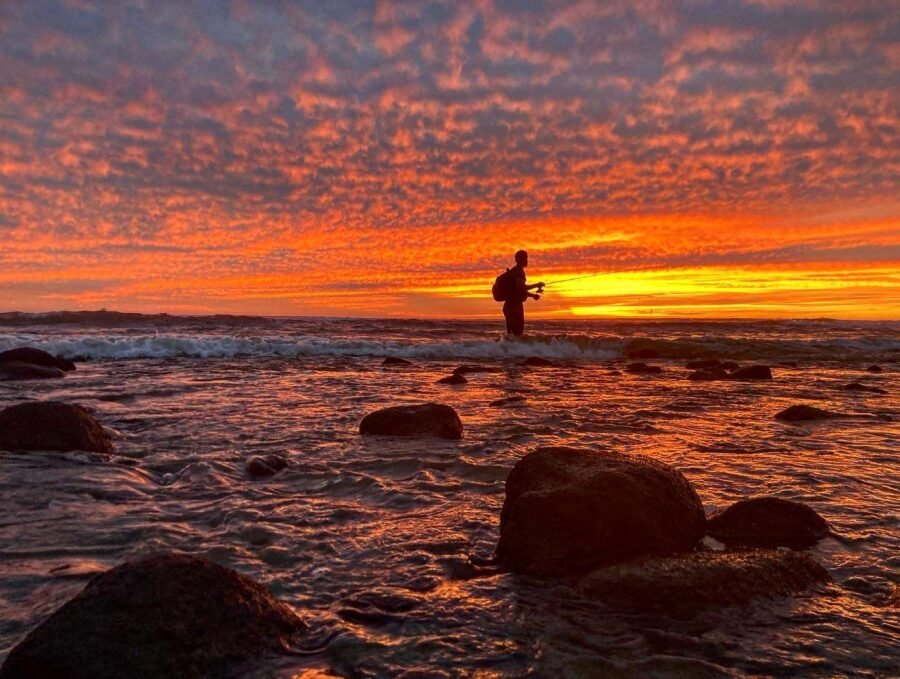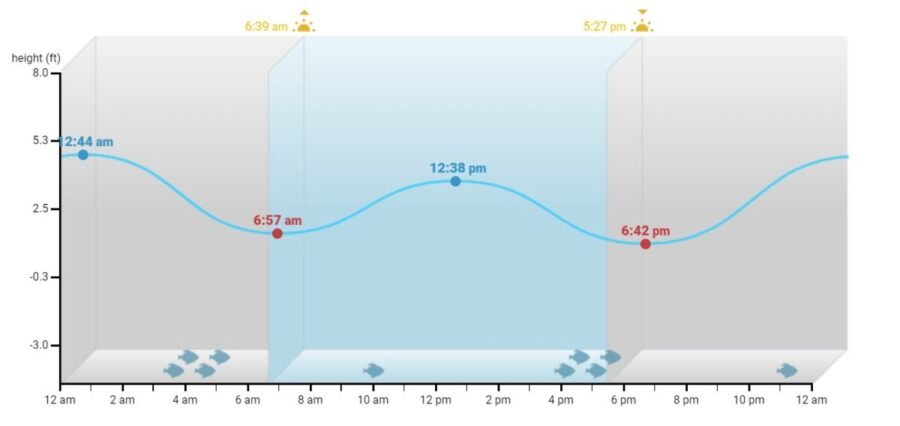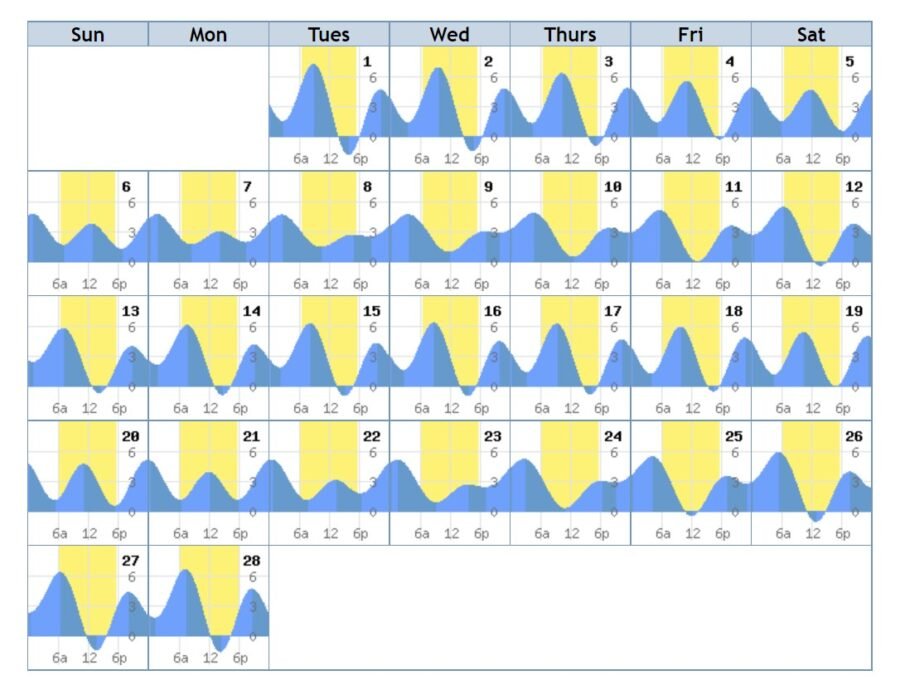How Do Tides Affect Surf Fishing? An Expert Guide

How do tides affect surf fishing? For some reason, tides receive a lot of attention when it comes to the analytics of conditions in determining the best times to go fishing. One of the most common questions for anyone entering the sport is, “what’s the best tide for fishing?” The truth is there are a number of factors to keep in mind when planning to go surf fishing, but let’s talk about tides and what they mean for fishing.
Tides can affect where and when you fish on any given day so it’s important to know why and how to plan accordingly. Below are the three main aspects of tides with respect to how they affect fishing.
- Tidal Height
- High tide = bigger waves.
- Low tide = smaller waves.
- Extreme high tides can make some spots unfishable, inaccessible, or dangerous.
- Extreme low tides will expose hard structure.
- Tidal Phases (Rising or Falling)
- A rising tide will bring fish in closer to shore.
- A falling tide can pull fish away from shallow areas.
- Tidal Swings
- Large tidal swings can stir up the water, the bait, and the seaweed.
- Neap tides can help if structure you like is submerged all session.
Tidal Height
The actual height of a tide has the most direct effect on fishing. For those who are unaware, tides are defined as follows: “the alternate rising and falling of the sea, usually twice in each lunar day at a particular place, due to the attraction of the moon and sun”. Tides affect fishing from the surf, the bay and even inshore.

Fishing at High Tide
Depending on what the tidal height is at a given beach can determine which beach you decide to fish. If the tide is too high, some beaches will be inaccessible or too dangerous to fish. Know what your local beaches can handle in terms of tidal height before you go out.
Are waves bigger at high tide?
When fishing during high tides or higher tidal heights than the average, you can typically expect the waves to have more energy and to be built up a little higher. More specifically, waves will be bigger during the incoming tide leading up to high tide.
If the surf is a little high on a given day (above 3-4 feet), fishing the incoming might get a little rough where the outgoing to low tide might be a bit more friendly.
Fishing at Low Tide
Low tides are extremely valuable when it comes to scouting beaches, reading the surf, and learning where permanent structure exists. A King Tide is a term that is used for the highest tide of the year, and what comes with the highest tide of the year is typically one of the lowest tides of the year. When you get an extremely low tide, take the opportunity to scout some local beaches and get familiar with the structure like rocks, reefs, etc. Here’s some more on King Tides and why they’re good for fishing.
Is it Better to Fish at High Tide or Low Tide?
Some anglers will tell you one, and others will say the other. Some even say it depends what you’re targeting. What do I say? It depends where you’re fishing. High tide can be better for some beaches and low tide can be better for other beaches.
I have spots that are good for every tide. Some are good for low tide and other beaches are good for high tides. I literally have spots that I know produce when the tidal height is between 2 feet and 5 feet, and others that are completely different. I even have spots where the tidal height doesn’t matter at all. Why? Because of the structure. It comes down to whether the tidal height allows for proper coverage of good structure, yet still within casting range.
For hard structure, this is easy, know your casting range, know where the hard structure (rocks, reefs, etc.) is, and know at what height that structure is submerged enough to hold fish but still just within your casting range. That’s the sweet spot.
For sandy beaches, it doesn’t matter too much because the structure there (troughs, holes, scallops, etc.) changes on a daily basis so you need to rely on your eyes in knowing how to read the surf. The same applies, fish the structure that you find when it’s submerged enough to hold fish and still within your casting range.
Fishing the Incoming Tide vs the Outgoing Tide
We talked a little bit about how the incoming tide will increase wave height and the outgoing tide will decrease wave height. But, we didn’t talk about the other side of the equation.
Fishing an Incoming Tide
A rising tide, although it can make conditions a little less manageable, can bring fish closer into shore. An incoming tide is felt by the fish in the water and with a rising water level, baitfish and other bigger fish will be more inclined to swim into the shallower water. Theoretically, during an incoming tide, the density of fish closer to shore should be higher than during a falling tide.
Fishing an Outgoing Tide
A falling tide, although it can help to mellow the conditions, can potentially pull fish further out from the shoreline. Why? take a look at the scenario below.
You find a fishing spot with incredible structure that’s submerged enough to hold fish and still within your casting range. There’s a nice hole about 40 feet in front of you and the depth goes from about 2 feet, down to 4 feet, and back up to 2 feet before continuing it’s gradual slope out to sea.
Fish are smarter than we give them credit for and they can sense whether the tide is rising or falling. If a halibut has been holding in that spot through a rising tide, it knows it can easily retreat to deeper water at any time. There’s plenty of coverage and it’s growing by the minute. But, as the tide starts to fall, and that coverage of 2 feet becomes 1 foot, the halibut might feel like its escape window back to deeper water is dwindling. It might leave the hole to find another that’s surrounded by slightly deeper water.
Is it Better to Fish a Rising Tide or a Falling Tide?
So which is better than? The general consensus is that it’s better to fish a rising tide than a falling tide. Meanwhile, I keep detailed logs of all my outings and I can’t say I’ve seen a meaningful difference in my results. But, you won’t find many anglers that argue a falling tide is better than a rising tide, including myself.
Tidal Swings

The notion here is that when a tidal swing is larger (the range is wider), there’s more movement in the water which helps to stimulate fish activity and feeding.
My simple philosophy to this one is that if the conditions are manageable, seaweed is light, current is mild, and surf is low, larger tidal swings are good.
If it’s weedy, there’s rough surf, heavy current or other unfavorable conditions, the large tidal swing will only emphasize those unfavorable conditions and churn up the water too much to manage.
But, as mentioned earlier, King Tides (which naturally require large tidal swings) have their benefits. Additionally neap tides, or “a period of moderate tides when the sun and moon are at right angles to each other”, can be beneficial, when the tidal height supplies optimal coverage within casting range for prolonged periods of time.
What’s the Best Tide for Fishing?
So, to get back to that extremely common question, the best tide for fishing is for you to figure out. It’s going to depend on a lot of things. It’s going to vary per beach, per species, and even per angler at times. Put in the time, and you’ll nail down the tide! If you’re looking to learn more about surf fishing, follow the link.
I hope this helped some anglers understand more about how tides affect fishing. If you feel I missed something, please drop it in the comments and same goes for any questions. Tight lines out there guys!
Subscribe to our newsletter!
Great point regarding Halibut moving in or out ahead of where the tide will soon be. Fascinating. Thanks, Nick!
Thanks, Kurt!
GREAT ARTICLE NICK…. THANKS
Thanks, Richard!